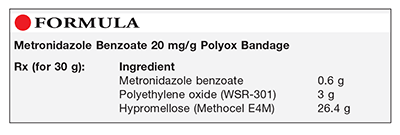US Pharm. 2015;40(4):45-46.

Method of Preparation: Calculate the quantity of each ingredient for the amount to be prepared. Accurately weigh or measure each ingredient. Reduce the particle size of the metronidazole benzoate in a glass mortar. Mix all powders together using geometric dilution. Package preparation into two 1-oz. accordion insufflators (15 g into each 1-oz. insufflator).
Use: This preparation has been used in the treatment of odor-producing wounds and as a topically applied antibiotic powder. To use it, wet the affected area with Sterile Water for Irrigation. Puff the powder lightly onto the moistened area until it is covered. Repeat twice more the process of wetting and puffing the powder onto the wound. Cover the area with a sterile gauze, and wrap it with a Kerlix-type bandage. Repeat treatment once daily.
Packaging: Package the preparation in accordion insufflators. Additionally, dispense it with some Sterile Water for Irrigation packaged in a 30-mL bottle with a long-stem spray attachment to aid in application to the wound.
Labeling: Keep out of reach of children. Discard after ____ [time period]. For external use only. Keep away from the eyes and mucous membranes.
Stability: A beyond-use date of up to 6 months may be used for this preparation.1
Quality Control: Quality-control assessment can include weight, active drug assay, physical appearance, color, uniformity, and physical stability (discoloration or other changes).
Discussion: Pressure ulcers (bedsores) and other topical sores have been treated with this formulation for years. It is applied once daily only, with gentle cleansing prior to application of the powder. Both metronidazole and metronidazole benzoate have been used in these formulations.
Metronidazole benzoate (C13H13N3O4, MW 275.26) occurs as a white to slightly yellow, crystalline powder that is slightly soluble in alcohol and practically insoluble in water. Metronidazole benzoate should be stored in well-closed, light-resistant containers at room temperature. Metronidazole benzoate is used as an antibiotic.1
Polyethylene oxide (Polyox, WSR-301) is a nonionic homopolymer of ethylene oxide, represented by the formula [(OCH2CH2)n], in which n represents the average number of oxyethylene groups and varies from about 2,000 to 100,000; the molecular weights range from about 100,000 to 7 million. Polyethylene oxide occurs as a white to off-white, free-flowing powder, with a slight odor of ammonia. It is available in several different grades that vary in viscosity profiles in aqueous isopropyl alcohol solutions. Polyethylene oxide may contain a suitable antioxidant. It should be preserved in tight, light-resistant containers. Polyethylene oxide should be labeled to indicate its viscosity profile, along with the name and quantity of any added antioxidant. Polyethylene oxide strongly bonds with water, is nonionic, and undergoes salting-out effects. All grades of molecular weight occur as powdered or granular solids that are soluble in water, but because of the high solution viscosities obtained, solutions greater than 1% in water may be difficult to prepare. Twenty percent aqueous concentrations form gels that are nontacky and reversible. Polyethylene oxide is also freely soluble in acetonitrile, but it is insoluble in ethylene glycol, diethylene glycol, and glycerin. Polyethylene oxide melts at about 65°C to 70°C. Polyethylene oxide is incompatible with strong oxidizing agents.1,2
Hypromellose (hydroxypropyl methylcellulose, cellulose, hydroxypropyl methyl ether, Methocel, Pharmacoat) occurs as an odorless and tasteless, white- or creamy white–colored, fibrous or granular powder. Hypromellose is used as a coating agent, film-former, rate-controlling polymer, stabilizing agent, suspending agent, tablet binder, and viscosity-increasing agent. It is widely used in oral and topical formulations. The pH of a 1% aqueous solution is in the range of 5.5 to 8.0. Hypromellose is soluble in cold water, forming a viscous colloidal solution, and it is practically insoluble in alcohol. Hypromellose is available in a wide range of viscosity types. The Methocel E4M product discussed here has a nominal viscosity of 4,000 mPa.s for a 2% w/v aqueous solution at 20°C. It is listed as being incompatible with some oxidizing agents.3
REFERENCES
1. U.S. Pharmacopeia 38/National Formulary 33. Rockville, MD: U.S. Pharmacopeial Convention, Inc; 2014:559-611,1951,4381-4382,6808-6810.
2. Maximilien JS. Polyethylene oxide. In: Rowe RC, Sheskey PJ, Cook WG, Fenton MF, eds. Handbook of Pharmaceutical Excipients. 7th ed. Washington, DC: Pharmaceutical Press; 2012:591-593.
3. Rogers TL. Hypromellose. In: Rowe RC, Sheskey PJ, Cook WG, Fenton MF, eds. Handbook of Pharmaceutical Excipients. 7th ed. Washington, DC: Pharmaceutical Press; 2012:373-376.
To comment on this article, contact rdavidson@uspharmacist.com.





